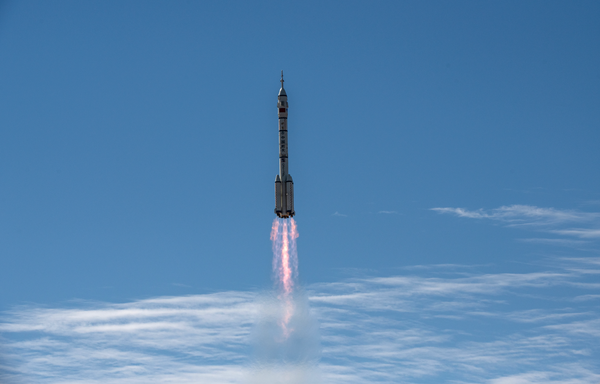China's new space station is about to get its first human visitors.
The
Shenzhou 12 mission launched Wednesday (June 16) from Jiuquan Satellite Launch Center in northwest China, rising off the pad atop a Long March 2F rocket at 9:22 p.m. EDT (0122 GMT and 9:22 a.m. Beijing time on June 17).
On supporting science journalism
If you're enjoying this article, consider supporting our award-winning journalism by subscribing. By purchasing a subscription you are helping to ensure the future of impactful stories about the discoveries and ideas shaping our world today.
Shenzhou 12 — China's first crewed spaceflight in nearly five years — is sending three astronauts to Tianhe ("Harmony of the Heavens"), the core module of the nation's
new Tiangong space station. If all goes according to plan, the trio will spend three months aboard the 54-foot-long (16.6 meters) Tianhe, performing a variety of tests and maintenance activities.
"We are honored to take the lead in a series of manned missions for the space station construction, and we have many expectations," Shenzhou 12 commander Nie Haisheng said during a press conference at Jiuquan on Tuesday, June 15 (June 16 Beijing time),
according to China's state-run Xinhua news agency.
"We will not only make the core module a 'space home' but also carry out a series of key technology verifications," Nie said. "There will be more arduous tasks and more challenges."
Nie had already made two trips to Earth orbit before today's launch, flying on the Shenzhou 6 mission in 2005 and commanding Shenzhou 10 in 2013. Joining him on Shenzhou 12 are two other men: Liu Boming, a veteran of Shenzhou 7 in 2008, and Tang Hongbo, who's a rookie spaceflyer.
Shenzhou 12's launch is the third of 11 that will be required to build China's new space station, which the nation expects to complete by the end of 2022. The first construction liftoff occurred on April 28,
sending Tianhe to low Earth orbit. The second came on May 29, lofting the robotic Tianzhou 2 cargo craft, which was packed with more than 6.6 tons of supplies and is still attached to the core module.
Tianhe's launch caused a certain amount of controversy, because the huge core stage of the module's Long March 5B rocket reached orbit and
crashed back to Earth out of control 10 days later. But this issue did not recur with Tianzhou 2, which launched atop a Long March 7 rocket, nor was it expected to with Shenzhou 12.
Two of the remaining eight assembly missions will loft "lab modules" named Wentian and Mengtian, which will attach on either side of Tianhe to form a T-shaped outpost about 15% as massive as the 450-ton
International Space Station (ISS). There will also be three more robotic resupply flights and three more crewed missions during the outpost's construction phase, Chinese space officials have said.
Paving the way
Shenzhou 12 was China's first crewed launch since October 2016, when Shenzhou 11 sent three astronauts to the
Tiangong 2 prototype space lab for a one-month stay.
As its name suggests, Tiangong 2 was the second such pathfinder vehicle, following Tiangong 1, which launched in September 2011. (China did not gain such experience via the ISS, because it's not a partner on the huge international project. In fact, since 2011, U.S. law has prohibited NASA and the White House Office of Science and Technology Policy from cooperating with their Chinese counterparts on space activities, unless Congress has approved such cooperation in advance.)
Tiangong 1 hosted two crews of three astronauts apiece — Shenzhou 9 and Shenzhou 10, which arrived in June 2012 and June 2013, respectively. Both crews spent about two weeks aboard the space lab.
Shenzhou 11 was the only crewed mission to Tiangong 2. But China also sent the Tianzhou 1 robotic cargo spacecraft to the space lab in April 2017, performing a series of docking and refueling tests with the freighter over the ensuing five months.
The technology-testing work of Tiangong 1 and Tiangong 2 wrapped up several years ago, and both space labs are now dead and gone.
Tiangong 1 fell to Earth out of control in April 2018, burning up over the Pacific Ocean. China brought Tiangong 2 down in a controlled manner in July 2019, also over the Pacific.
Lots of work to do
Tianhe is much larger and more complex than Tiangong 1 and Tiangong 2, both of which were 34 feet (10.4 m) long. The recently launched core module features three independent bedrooms and three times more interior space than its two predecessors, according to Xinhua.
Nie, Liu and Tang will help get Tianhe up and running. The trio have four main tasks during their three-month mission, Xinhua reported, citing China Manned Space Agency officials.
The astronauts will test, verify and operate the core module and its various systems; assemble and test spacesuits and perform two
spacewalks outside Tianhe; conduct science and technology experiments and public outreach; and manage and monitor their health.
The past few months have been action-packed for China's space program, and not just because of the Tianhe, Tianzhou 2 and Shenzhou 11 launches. On May 14, for example, the nation
landed its first-ever Mars rover on the Red Planet, and it continues to operate a rover on the moon's mysterious and largely unexplored far side.
Copyright 2021 Space.com, a Future company. All rights reserved. This material may not be published, broadcast, rewritten or redistributed.
